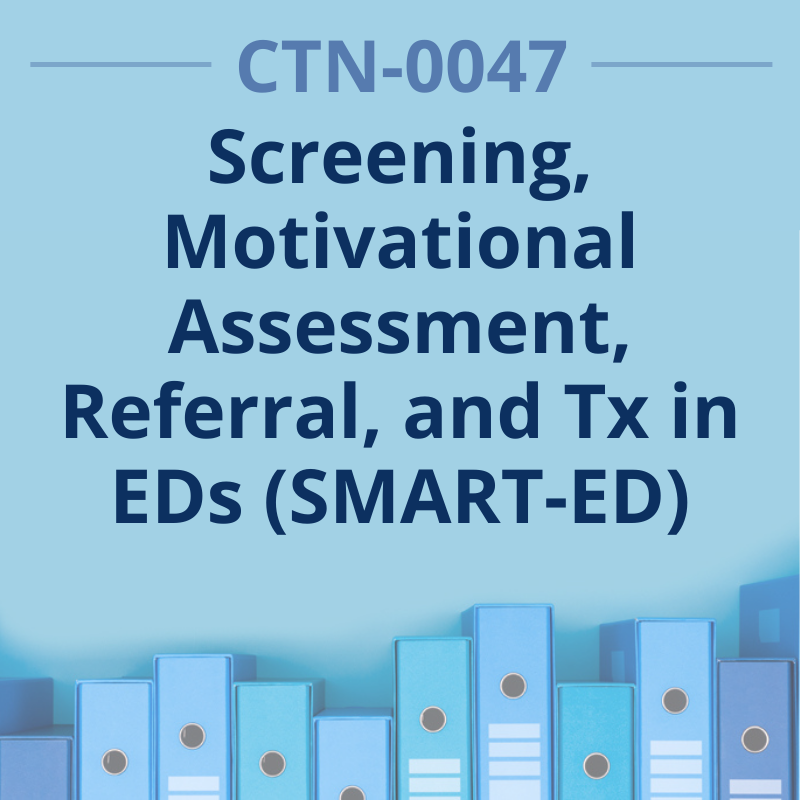CTN-0047: Screening Motivational Assessment and Referral to Treatment in Emergency Departments (SMART-ED): Evaluation of Screening, Brief Intervention, Referral to Treatment (SBIRT) and Booster Session for Drug Use Patients Presenting for Treatment in the Emergency Department

Michael Bogenschutz, MD
Lead Investigator
Center on Alcoholism, Substance Abuse, and Addictions (CASAA)
University of New Mexico
mbogenschutz@salud.unm.edu
Dennis M. Donovan, PhD
Co-Lead Investigator
Director, Alcohol and Drug Abuse Institute
University of Washington
ddonovan@u.washington.edu
The present study builds on the knowledge base in developing and implementing screening and brief interventions for harmful and hazardous alcohol use delivered in emergency departments and trauma centers, by transferring and evaluating these procedures when applied to drug use. The study will contrast substance use and substance-related outcomes among patients endorsing problematic substance use during an emergency department (ED) visit who are randomly assigned to one of three treatment conditions: 1) minimal screening only (MSO); 2) screening, assessment, and referral to treatment (if indicated) (SAR); and 3) screening, assessment, and referral plus a brief intervention (BI) with two telephone follow-up booster sessions (BI-B). The primary outcome is days of use of the patient-defined primary problem drug at 3 months following enrollment. Secondary outcomes include change from baseline in days of use of the primary substance, the number days abstinent from all drugs, days of heavy drinking, total quantity of drug use, objective change in drug use based on analysis of hair samples, self-reported consequences of drug and alcohol use, percent entering treatment among those classified as having probable dependence, and ED and other health care utilization.
Primary Findings
Follow-up rates were 89%, 86%, and 81% at 3, 6, and 12 months, respectively. There were no significant differences between groups in self-reported days using the primary drug, days using any drug, or heavy drinking days at 3, 6, or 12 months. At the 3-month follow-up, participants in the SAR group had a higher rate of hair samples positive for their primary drug of abuse (265 of 280, 95%) than did participants in the MSO group (253 or 287, 88%) or the BI-B group (244 of 275, 89%). Hair analysis differences between groups at other time points were not significant. The findings of this study suggest that even a relatively robust brief intervention such as the one implemented in this trial is unlikely to be useful as a general strategy for the population recruited in this trial (ED patients with relatively severe drug problems and other life challenges).

Primary Outcomes Article: Bogenschutz MP et al. Brief Intervention for Patients with Problematic Drug Use Presenting in Emergency Departments: A Randomized Clinical Trial. JAMA Internal Medicine 2014;174(11):1736-1745. [get article]
Related Studies
Related Resources
- CTN-0047 Study Protocol
- Publications in the Library about CTN-0047
- Study Data from NIDA Data Share
- Study Manual: Bogenschutz MP, Donovan DM. CTN-0047: SMART-ED. Brief Intervention and Telephone Booster Therapy Manual. Manual developed for NIDA Clinical Trials Network protocol CTN-0047 protocol team, University of New Mexico and University of Washington, (no date), 46p.
- ClinicalTrials.gov (NCT01207791)
- NIDA protocol page
Node Involvement
Lead Node(s):
All Participating Nodes: